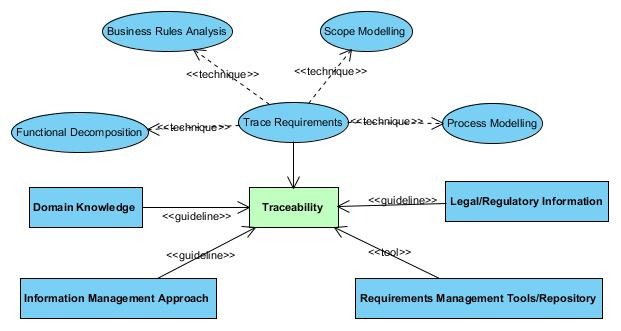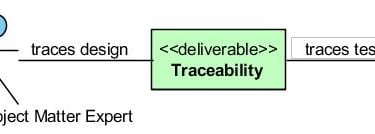Trace Requirements
Trace Requirements links requirements to requirement and design type artifacts. These links are maintained in a traceability repository.
Guidelines/Tools and Techniques
The guidelines/tools and techniques used to maintain traceability.


Trace Requirements - Uses Functional Decomposition, Business Rules Analysis, Scope Modeling and Process Modeling techniques to maintain Traceability.
Traceability – Uses Domain Knowledge, Legal and Regulatory Information, the Information Management Approach and Requirements Management Tools and Repository as tools and guidelines.
The relationships between these guidelines, tools, techniques and Traceability are detailed in the BABOK under the Guidelines and Tools and Techniques sections of the Trace Requirements task.
Workers
The people involved with tracing requirements.


The relationships between these roles and Traceability are detailed in the BABOK under the Stakeholders section of Trace Requirements task. The list of related stakeholders is significantly less that shown in the BABOK. [The reasons why stakeholders were removed:
Customer - In my experience, getting customers to read requirements is difficult, but necessary. Getting customers to understand traceability is not necessary.
Domain Subject Matter Expert - Linking requirements to a release is a project management concern, not the BA.
End User - Same reasoning as for a customer.
Operational Support - Is interested in the end product, not in the requirements.
Project Manager - Uses the results of traceability, such as change assessments, but does not contribute to traceability.
Sponsor - See customer.
Suppliers - See project manager.
]
Implementation Subject Mater Expert - Uses traceability to map the implementation to the requirements.
Tester - Uses traceability to map test cases to requirements.